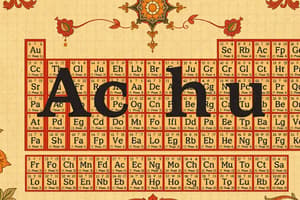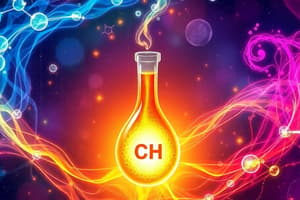Podcast
Questions and Answers
Which type of bond is formed by the transfer of electrons from one atom to another?
Which type of bond is formed by the transfer of electrons from one atom to another?
- Covalent bond (correct)
- Hydrogen bond
- Ionic bond (correct)
- Metallic bond
What is the primary difference between alkanes, alkenes, and alkynes?
What is the primary difference between alkanes, alkenes, and alkynes?
- Alkanes are more reactive than alkenes and alkynes.
- Alkanes can form cyclic structures, whereas alkenes cannot.
- Alkanes contain only single bonds, alkenes contain double bonds, and alkynes contain triple bonds. (correct)
- Alkenes and alkynes have the same bonding type.
What does the term 'dynamic equilibrium' refer to?
What does the term 'dynamic equilibrium' refer to?
- The rate of the forward and reverse reactions are identical. (correct)
- The state when all reactants are converted to products.
- The conditions under which a reaction stops.
- The point at which all chemical reactions begin to be reversible.
Which factor does NOT affect the reaction rate?
Which factor does NOT affect the reaction rate?
How do acids and bases differ in their behavior regarding proton transfer?
How do acids and bases differ in their behavior regarding proton transfer?
What does the pH scale measure?
What does the pH scale measure?
Which type of reaction is represented by the equation AB + CD → AD + CB?
Which type of reaction is represented by the equation AB + CD → AD + CB?
What role does activation energy play in a chemical reaction?
What role does activation energy play in a chemical reaction?
Flashcards are hidden until you start studying
Study Notes
Basic Concepts of Chemistry
-
Matter: Anything that has mass and occupies space.
- States of matter: solid, liquid, gas, plasma.
-
Atoms: Basic unit of matter.
- Composed of protons, neutrons, and electrons.
- Atomic number: number of protons in the nucleus.
-
Molecules: Two or more atoms bonded together.
- Types: covalent (sharing electrons), ionic (transfer of electrons).
The Periodic Table
- Elements: Pure substances consisting of only one type of atom.
- Organized by increasing atomic number.
- Groups: vertical columns (similar properties).
- Periods: horizontal rows (energy levels).
Chemical Bonds
- Ionic Bonds: Formed through the transfer of electrons from one atom to another.
- Covalent Bonds: Formed by the sharing of electrons.
- Metallic Bonds: Electrons are shared among a lattice of metal atoms.
Chemical Reactions
- Reactants: Substances that undergo a chemical change.
- Products: Substances formed from the reaction.
- Types of Reactions:
- Synthesis: A + B → AB
- Decomposition: AB → A + B
- Single Replacement: A + BC → B + AC
- Double Replacement: AB + CD → AD + CB
- Combustion: Hydrocarbon + O₂ → CO₂ + H₂O
Stoichiometry
- Mole: A unit to count particles (6.022 × 10²³).
- Molar Mass: Mass of one mole of a substance (g/mol).
- Balanced Equations: Must have the same number of each type of atom on both sides.
Acids and Bases
- Acids: Donate protons (H⁺ ions); pH < 7.
- Examples: HCl, H₂SO₄.
- Bases: Accept protons; pH > 7.
- Examples: NaOH, Ca(OH)₂.
- pH Scale: Measures acidity/alkalinity (0-14 scale).
Thermodynamics
- Endothermic Reactions: Absorb heat (ΔH > 0).
- Exothermic Reactions: Release heat (ΔH < 0).
- Activation Energy: Minimum energy required for a reaction to occur.
Kinetics
- Reaction Rate: Speed at which reactants convert to products.
- Factors affecting reaction rates:
- Concentration
- Temperature
- Surface area
- Catalysts
Chemical Equilibrium
- Dynamic Equilibrium: Rate of forward reaction equals rate of reverse reaction.
- Le Chatelier's Principle: If a system at equilibrium is disturbed, the system will adjust to counteract the disturbance.
Organic Chemistry
- Hydrocarbons: Compounds composed of carbon and hydrogen.
- Types: alkanes (single bonds), alkenes (double bonds), alkynes (triple bonds).
- Functional Groups: Specific group of atoms within molecules that determine characteristic chemical reactions.
Inorganic Chemistry
- Metals: Typically good conductors of heat and electricity, malleable, ductile.
- Nonmetals: Poor conductors, brittle in solid form, varied properties.
- Metalloids: Have properties of both metals and nonmetals.
Safety in Chemistry
- Personal Protective Equipment (PPE): Lab coat, gloves, goggles.
- Chemical Hygiene: Proper handling, storage, and disposal of chemicals.
- Emergency Procedures: Knowledge of fire extinguishers, eyewash stations, and first aid.
Basic Concepts of Chemistry
- Matter includes anything with mass and volume, classified into four states: solid, liquid, gas, and plasma.
- Atoms are the fundamental units of matter, made up of protons, neutrons, and electrons.
- Atomic number identifies an element and equals the number of protons in its nucleus.
- Molecules consist of two or more atoms bonded chemically and can form via covalent bonds (electron sharing) or ionic bonds (electron transfer).
The Periodic Table
- Elements are unique substances formed from single types of atoms and organized by atomic number.
- The table features groups (columns) sharing similar chemical properties and periods (rows) indicating energy levels of electrons.
Chemical Bonds
- Ionic bonds result from the transfer of electrons between atoms, leading to charged ions.
- Covalent bonds are formed when two atoms share electrons to achieve stability.
- Metallic bonds involve a shared pool of electrons around a lattice of metal ions.
Chemical Reactions
- Reactants undergo change during reactions, producing products as outcomes.
- Various reaction types include:
- Synthesis (A + B → AB)
- Decomposition (AB → A + B)
- Single Replacement (A + BC → B + AC)
- Double Replacement (AB + CD → AD + CB)
- Combustion (Hydrocarbon + O₂ → CO₂ + H₂O)
Stoichiometry
- A mole is a measurement representing 6.022 × 10²³ particles of a substance.
- Molar mass indicates the mass of one mole of a substance, measured in grams per mole (g/mol).
- Balanced chemical equations require that the number of each type of atom remains equal on both sides.
Acids and Bases
- Acids, characterized by pH values less than 7, donate protons (H⁺ ions); examples include hydrochloric acid (HCl) and sulfuric acid (H₂SO₄).
- Bases accept protons and have pH levels greater than 7; examples are sodium hydroxide (NaOH) and calcium hydroxide (Ca(OH)₂).
- The pH scale, ranging from 0 to 14, gauges the acidity or alkalinity of solutions.
Thermodynamics
- Endothermic reactions absorb heat, indicated by a positive change in enthalpy (ΔH > 0).
- Exothermic reactions release heat, reflected by a negative change in enthalpy (ΔH < 0).
- Activation energy is the threshold energy required for a chemical reaction to take place.
Kinetics
- The reaction rate describes how quickly reactants become products and is influenced by factors like concentration, temperature, surface area, and the presence of catalysts.
Chemical Equilibrium
- Dynamic equilibrium occurs when the forward and reverse reaction rates are equal, establishing a steady state.
- Le Chatelier’s Principle suggests that a system at equilibrium will adjust in response to changes or disturbances to restore balance.
Organic Chemistry
- Hydrocarbons consist of only carbon and hydrogen atoms, classified into alkanes (single bonds), alkenes (double bonds), and alkynes (triple bonds).
- Functional groups are specific collections of atoms in organic molecules responsible for distinct chemical properties and reactivity.
Inorganic Chemistry
- Metals are generally good conductors of heat and electricity, showing ductility and malleability.
- Nonmetals exhibit poor conductivity, are usually brittle, and possess diverse properties.
- Metalloids display intermediary characteristics between metals and nonmetals.
Safety in Chemistry
- Personal protective equipment (PPE) like lab coats, gloves, and goggles are essential for safety.
- Chemical hygiene practices ensure proper handling, storage, and disposal of hazardous substances.
- Awareness of emergency procedures is crucial, including knowing the locations of fire extinguishers, eyewash stations, and first aid kits.
Studying That Suits You
Use AI to generate personalized quizzes and flashcards to suit your learning preferences.




